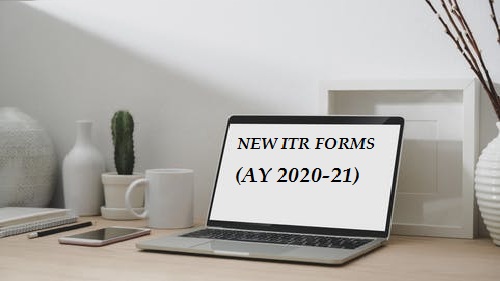The Central Board of Direct Taxes (CBDT) has notified the Income Tax Return Form ITR 1 Sahaj, 2, 3, 4 Sugam, 5, 6, 7 and ITR-V for the Financial Year 2019-20 (Assessment Year 2020-21). These forms are in line with the amendments made by the Finance Act 2019.
In the new income tax return form, it has been made mandatory for the taxpayers to give information about big expenses during the year. It will be mandatory to give information related to high value transactions such as depositing cash, more than one crore rupees in a person’s current account, expenses of two lakh rupees or more on foreign travel, or electricity bills of more than one lakh rupees during the year.
Highlights of New ITR Forms:-
ITR 1 Sahaj: This form is for citizens whose total income is up to Rs. 50 lakhs; They get income from interest on bank deposits, salary, a house property and other sources. Also, agricultural income is up to Rs 5000 (not for individuals who are either directors in a company or who have invested in unlisted equity shares).
ITR 2: This form is for those individuals and HUFs who do not have income from business or profession profits.
ITR 3: It is for those individuals and HUFs who earn a profit from business or profession.
ITR 4 Sugam: This form is for individuals, HUFs and firms (other than LLP) who have a total income of up to Rs 50 lakh as a resident of a citizen of India and who have income from a business and profession and takes benefit of presumptive shceme of Income Tax Act, U/s 44AD, 44ADA and so on.
ITR 5: It is for the persons other than- Individual, HUF, company and person filing Form ITR-7.
ITR 6: For companies other than companies claiming exemption under section 11.
ITR 7: For persons including companies required to furnish return under sections 139(4A) or 139(4B) or 139(4C) or 139(4D) only.
Changes in ITR forms for FY 2019-20 or AY 2020-21:
1) If you have taxable income as dividend from domestic companies, you are not eligible to file ITR-1 form.
2) Those with joint ownership of a house property cannot file ITR-1 or ITR-4.
3) In case the assessee is filing Return of Income under Seventh provision to Section 139(1) and was otherwise not required to file Return of Income, following additional details have to be furnished while filing ITR-1, ITR-2, ITR-3 or ITR-4:
- a) Details of deposit exceeding Rs 1 crore in one or more current account(s).
- b) Details of foreign travel expenditure exceeding Rs 2 lakhs (for self or for any other person).
- c) Details of electricity expenses exceeding Rs 1 lakh.
4) The income tax department has allowed taxpayers the laxity of making certain tax saving investments for FY 2019-20 till 30th June 2020 in view of the coronavirus lockdown. Deductions under Chapter-VIA-B of IT Act which includes Section 80C (LIC, PPF, NSC, etc), 80D (mediclaim) and 80G (donations) will now be allowed for spending till June 30th. The dates for making investment, construction or purchase for claiming roll over benefit in respect of capital gains under sections 54 to section 54GB has also been extended to June 30.
5) In ITR-4, under “Schedule BP”, while calculating the Gross Turnover or Gross Receipts under Section 44AD, amounts received through prescribed electronic modes has been incorporated in addition to amounts received through account payee cheque, account payee bank draft and bank electronic clearing system.
6) In ITR-4, while calculating presumptive income from goods carriages under Section 44AE, the celling of maximum 10 rows has been removed.
Still have a Question, we may be reached at “Connect Us”




